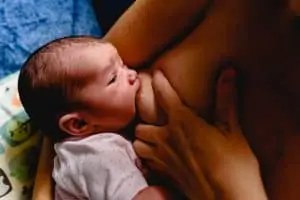Our bodies produce milk naturally, but when it comes to nursing your first baby for the first time, it may feel like a completely foreign experience. It certainly did for me. After all, I’d only held one baby in my entire life before then. This was uncharted territory.

This is why I’m eternally thankful for Vivien, my breastfeeding coach, who showed me the ropes both before I gave birth and afterward to help me get the whole breastfeeding thing down right.
Several different breastfeeding positions are suitable for newborns. You may find some of them more comfortable than others. For all of them though, a good latch is of utmost importance.
For now, let’s help you assume the right position for breastfeeding a newborn.
Best Breastfeeding Positions for Newborn Babies
With each of these positions, it will require practice. Ultimately, you should go with whatever works for you and your baby.
Laid-back position
Sometimes this one is called “biological nursing.” It’s an excellent position for newborns, and once your baby is bigger, if he happens to have lots of gas. Laid-back is one of the best breastfeeding positions for reflux newborns too. If you have small breasts, this one will also be a lot easier to do.
I’ve talked about the laid-back position before which you can read here in more detail. I think it’s a great one for when you have a newborn because it makes getting that latch easy for a newborn. This was the first position Vivien got my eldest in on me in the hospital after my c-section.
It’s easy to maneuver your baby away from your incision if you have a c-section, though you may need help as I did from someone who knows what they’re doing. That first nursing session is the most important one, and I’m so glad I had Vivien there to help me.
With the laid-back position, gravity keeps your baby in place and allows her to find your breasts and latch on easily. Once latched on, you should let your baby nurse for as long as possible.
Cradle and Crossover Holds
I’ve lumped these together here because I’ve written about how to get into each of these positions before. Each of these is great for newborns though if you’ve delivered vaginally. If you’ve had a c-section, these will be very uncomfortable until you heal.
The difference between these two positions is whether you use the crook of your arm to support your newborn’s head or your opposite hand. Both can be very comfortable for you and your baby, making for a secure latch, though you may want to use a pillow to help baby reach your breast more easily.
Incidentally, for these, it helps to be sure you’ve got your baby in a good position himself. He should be on his side, facing toward your breast. The ear, shoulder, and hip on that side should go for a straight line. This makes your breastfeeding efforts much more effortless.
Football Hold
I’ve also written about the football or clutch position. It’s fantastic for those of you who have big breasts, a very small or even premature baby, have twins (one in each arm!), or if you’ve had a c-section as I did.
This is one of the upright breastfeeding positions newborns do best with which is suitable for milk flow. If you’re out with your baby after a c-section, you’ll favor this one because you’ll be able to get a great latch and still be comfortable.
Side-Lying Position
And finally, my favorite newborn breastfeeding position. I’ve talked about this one in greater detail, but this is ideal when you’re at home with the baby. As someone who had c-sections for both my babies, I found this one to be particularly comfortable afterward. It was also the chosen position for my girls and me even long after I had them.
I favored this position because it was comfortable for both my girls and me when we were at home. When we were out though, it was the football hold all the way.
A Quick Tip:
When in this position, please take care to keep excess bedding (like blankets) away from your baby to avoid suffocation. You should also avoid doing this on a couch or recliner. It’s never advisable to try this on a water bed either.
Here I’ve put together some of the unusual breastfeeding positions worth trying.
Avoid these Breastfeeding Positions
The positions I’ve mentioned above are great for breastfeeding a newborn. Some you will favor over others, just as I did. It’s all about what gets the job done. I highly recommend you find a breastfeeding coach to help you get it right those first few days because that is critical for your milk production. I’ll discuss feeding frequency in just a moment, so keep reading.
Before I go on though, please make sure you check out my other posts on:
When it comes to breastfeeding positions to avoid with a newborn, you must take care that your baby is in the right place. That’s why I recommended getting your very own Vivien because she will be able to help you get it right and get comfortable with it so you can do it all on your own.
Getting into position correctly means your breasts will be stimulated to keep creating that milk. To ensure that happens, avoid doing the following breastfeeding positioning no-no’s:
Hunching
One of the most common reasons for improper latching is due to hunching over when feeding. Whichever position you choose, you’re doing it wrong if you’re hunched over your baby attempting to shove your breast into his mouth. Your back should be straight, and you should bring your baby up to your breast. Pillows behind you and under baby can help.
Baby’s head and body in different directions
Your baby’s head must be in line with his body. Don’t lay him on his back and turn his head to the side. This makes it much more difficult for him to eat and could cause tummy troubles.
Keeping baby too far
Your newborn baby should be as close as possible to you. Ideally, in the first few weeks, you should have skin-to-skin contact for better bonding. But aside from that, when your baby is too far away, that means pulling on your nipples to get the milk. Not only is that unsatisfying for your baby but it’s also quite painful for you. Readjust quickly!
Watch Out for Digestive Problems
It’s important to watch how your baby behaves after your feedings. Their tiny digestive systems aren’t fully developed yet. That means they’re prone to a couple of things.
Gas
Many newborn babies gulp down air during their feedings. This becomes uncomfortable and can create a colicky baby. Getting that latch right means they’ll swallow less air, though any time they cry excessively, it can lead to greater gas. You should burp your baby when you switch breasts in your feedings and afterward too.
Additionally,
You may want to change positions. If you notice the football hold is causing your baby to get gassy, try the laid-back position and see if that makes a difference.
Reflux
Most babies spit up, usually when you forget a burp cloth. I know, I can attest to this! Some spitting up between feedings is normal for newborns. Again, their little digestive systems are still developing. Spitting up is no cause for concern unless your baby isn’t gaining enough weight. You can address your concerns with your doctor who can help determine if the weight your baby is putting on is sufficient or not.
Other times, though more rarely, it’s because of GERD (gastroesophageal reflux disease) which your doctor can help with too. With reflux problems, keeping the baby more upright is the best way to keep things down. His head should always be higher than the rest of his body. Try propping him up safely after feedings to help keep things from coming up.
If your baby must nap, you can add an incline to the crib. Put it UNDER the mattress as anything additional in your baby’s crib could be a danger to them and increase the chances for SIDS.
Breastfeeding Frequency for Newborns

As I’ve said before, the first time, you ever breastfeed your newborn baby should be as soon as humanly possible after giving birth. It should ideally be done with skin-to-skin contact. Your newborn should nurse a minimum of 8 times in the first 24 hours. This is confirmed by research from the AAP (American Academy of Pediatrics) and the AAFP (American Academy of Family Physicians).
You can tell that things are going well by how many soiled diapers you get. Whether it’s pee or poop, you’ll see about four dirty diapers in the first 24 hours. These early feedings not only give your baby necessary antibodies in your colostrum but they also help send the message to your body to produce full-on milk.
Should I Stick to a Breastfeeding Schedule?
When it comes to breastfeeding frequency, it helps to dig into what La Leche League shares on that. There seems to be a huge misconception that breastfeeding mamas need to follow a schedule. Let me help clear that up.
The thing is, scheduling is for formula-fed babies. There is no set schedule you should be on with your breastfeeding baby. Trying to set a timeframe for every nursing session is going to lead to slow weight gain. It can also cause early weaning because when you schedule your nursing sessions instead of going on demand, you decrease your milk production.
Day and night, particularly during those first six weeks, you should go on your baby’s cues and follow when he seems hungry. After all, the time of day is insignificant if your baby is hungry. Paying attention to how your baby acts will tell you when they need to eat.
Don’t forget that crying is a late cue for feeding. You should look for the following early signs your baby is getting hungry:
- Active eyes underneath the eyelids
- Fluttering eyelids while still closed
- Movements of the mouth
- Moving hands toward the mouth
- Greater alertness
If you miss these signs, and you will because we all do when we’re newbies to the mom-thing, then you may notice your newborn whimpering or squeaking while becoming more physically active. And if you miss that, he’ll start crying away, and you’ll know he’s hungry.
The earlier you respond, the better it is for both of you. Yes, you’re going to feel like a boob slave as I always called it, but this period won’t last forever. Your baby’s stomach is growing, and so is the capacity it has for your milk. Babies will go from one to two ounces per feeding capacity in the first few days and then go to between 10 and 20 ounces per day after day 4.
So it may feel like you just fed your baby, and I know because I seriously felt like that’s all I was ever doing. My eldest would finish, I’d jump up with glee to go to the bathroom and attempt to eat something and then it would seem she was hungry all over again.
When I called Vivien, she explained this was very normal and told me about how the tummy grows for babies. The time between nursing sessions isn’t from the moment it ends. It’s from the beginning of one session to the beginning of the next. So your baby may nurse for 45 minutes and then be ready for more just 45 minutes after that.
Final Thoughts
Breastfeeding positions for newborns listed above are the best options though you must choose what works best for you and your baby. Watching your baby’s cues for hunger will help you avoid the screaming and crying and cut down on excess gas and digestive issues.
There’s no way to put a breastfeeding newborn on a schedule for eating. Feed your baby as often as you notice those hunger cues. Your days will consist of nursing your baby, but I promise you, they grow up so fast. Remember there is an end to this phase and it comes quickly so enjoy those cuddles and loves while you can!
Leslie Berry lives with her husband and two young daughters in Los Altos, California, where she loves helping other moms get comfortable with motherhood and embracing the insanity with facts peppered with laughs.
She loves eating too much sushi, exercising, and jamming out on her Fender. Read more about Leslie here.






